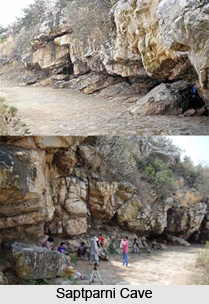 Saptparni Cave which is also known as Sattaparnaguha Cave is an ancient and pre historic cave in Bihar. This cave was the venue of the First Buddhist Council in ancient India.
Saptparni Cave which is also known as Sattaparnaguha Cave is an ancient and pre historic cave in Bihar. This cave was the venue of the First Buddhist Council in ancient India.
Location of Saptparni Cave
Saptparni Cave is located on a hill where the first Buddhist council was held immediately after Buddha attained Nirvana. The cave is a source Rajgir`s hot springs, having curative properties, thus making it sacred to the Hindus and Buddhists.
Depiction of Saptparni Cave in Ancient Texts
This place substantially agrees with the description of Saptaparni Cave found in Pali Language and Sanskrit Buddhist texts, where the First Buddhist Council, attended by five hundred monks, was held about six months after the death of Gautama Buddha to conserve and spreading the teachings of Gautama Buddha.
Venue of Saptparni Cave
Saptparni Cave is a venue of First Buddhist Council that was held in 400 BC. It was held soon after the Mahaparinirvana of Gautama Buddha under the patronage of king Ajatshatru with the monk Mahakasyapa presiding, at Rajgir or Rajgriha, in the Sattapani Cave.
Purpose of First Buddha Council
The idea of First Buddhist Council was to preserve Buddha"s teachings (Sutta) and rules for disciples (Vinaya). Ananda, one of the great disciples of Buddha recited Suttas and Upali, another disciple recited Vinaya. Abhidhamma Pitaka was also included. Saptparni Cave is believed to be once meditation place for the Buddha. The first Buddhist Council lead by Mahakashyapa, one of Gautama Buddha"s main disciples, was held here and the texts on Buddha"s teachings were put to writing. This event took place after about six months after the death of Gautama Buddha.
Jain Temples near Saptparni Cave
There are important Jain temples on the way to the Saptaparni caves. A partially ruined ancient Shiva temple is also found here. There are signs of unexcavated mounds nearby. The pillars of the temple are plain and octagonal. The front roof had been destroyed and the Shiva lingam is enshrined in the inner chamber.
Way to Saptparni Cave
A rock-strewn path from Pipala cave leads to the seven caves of Saptaparni. There is temple dedicated to Lord Shiva or Mahadeva on the summit of the hill, and further there is the largest modern Jain temple of Adinatha. A few metres to the east of the temple is a tiny shrine behind which, to the right, there is a narrow footpath descending the rugged northern scarp of the ridge to a level of about 30 metres below the temple and leading to a long artificial terrace in front of a line of six caves, all contained in a semicircular bend of the rock. One part of this path is paved with stones and looks like a causeway 1.82 m wide. Four of the caves are in a fairly good state of preservation. The terrace in front of the caves is about 36.57 metres long and 10.36 metres wide at the east and 3.65 metres at the west. The retaining wall marking the outer edge of the terrace was constructed of large stone set without any mortar, but only a small part of it, about 5 metres long and 2.4 metres high, has survived.











